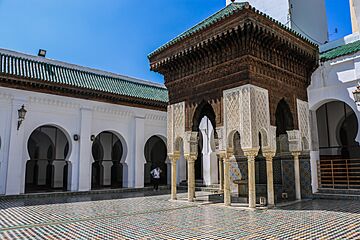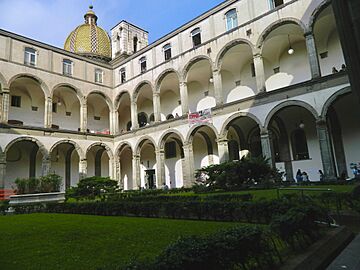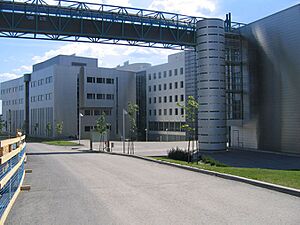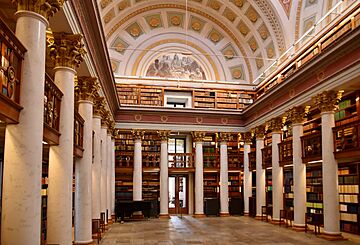University facts for kids
A university is a special school for advanced learning and research. It gives out academic degrees in many different subjects. The word university comes from a Latin phrase that means "community of teachers and scholars." Universities usually offer programs for both new students (undergraduate) and those who want to study more after their first degree (postgraduate).
The very first universities in Europe were started by Catholic Church monks. The University of Bologna in Italy, founded in 1088, is often called the first university. It was one of the first to give out advanced degrees and use the word universitas. It was also independent from church schools, teaching both religious and non-religious subjects like grammar, logic, and law.
Contents
History of Universities
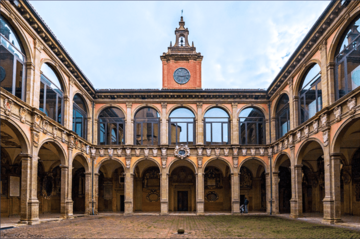
What is a University?
The original Latin word universitas meant a group of people joined together, like a club or a community. In the Middle Ages, groups of students and teachers formed these "guilds." They had special legal rights, often given by kings or towns. Like other guilds, they made their own rules and decided who could join.
Today, a university means a place for higher learning that teaches many different subjects. It also has the power to give out degrees. The main idea now is about learning and degrees, not just being a special club.
These early universities started in Western and Central Europe. From there, the idea of a university spread all over the world.
Freedom to Learn
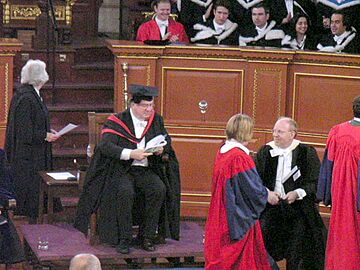
An important idea for universities is "academic freedom." This means scholars can study and teach without being stopped. One of the first times this idea was written down was at the University of Bologna in 1155 or 1158. It said that traveling scholars had the right to move freely for education. This is seen as the start of academic freedom.
Today, this idea is accepted around the world. In 1988, many university leaders signed the Magna Charta Universitatum. This document supports academic freedom and the independence of universities.
Early Learning Places
Some very old learning places are sometimes called universities, like the Harran University from the 8th century. The University of al-Qarawiyyin in Morocco, started in 859 CE as a mosque, is also sometimes called a university. However, some experts say it was more like a religious school (madrasa) until it became a modern university in 1963.
Some historians think that early European universities were influenced by madrasas in places like Spain and the Middle East. Others say this influence might be less than thought. Still, many agree that ideas from the Islamic world helped shape higher education in Europe.
Universities in Medieval Europe
The modern university as we know it began in Medieval Christian Europe. For hundreds of years, advanced learning happened in church schools. Monks and nuns taught classes. Young men would go to these schools after learning basic subjects like grammar, rhetoric (speaking well), logic, math, geometry, music, and astronomy.
The first universities were often started by the Latin Church or grew from existing church schools. Later, kings also founded universities, but usually with the Pope's approval. Many historians believe that universities continued the love for learning that monasteries had promoted. A Pope named Gregory VII helped by ordering the creation of cathedral schools in 1079, which later became the first European universities.

The first universities in Europe with a guild-like structure were the University of Bologna (1088), the University of Paris (around 1150), and the University of Oxford (1167). Bologna started as a law school, teaching Roman law. It is known as the oldest university that was independent from kings or religious groups.
In Bologna, students actually had a lot of power over their teachers! They came from many lands to learn. Across Europe, leaders saw that universities could help society by creating smart people who could solve problems. The rebirth of interest in ancient Greek texts also helped this idea grow.
The discovery of Aristotle's writings, which were translated into Latin, sparked a lot of new questions about nature. Many scholars believe this was a huge moment in Western thinking. People tried to combine ancient Greek ideas, especially about the natural world, with church teachings. This approach, called "scholasticism," used logic to understand the Bible and the world.
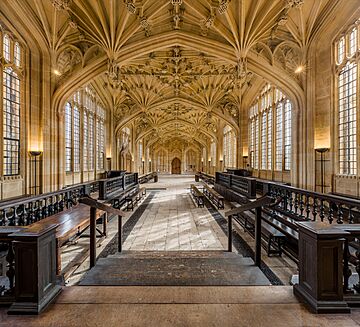
University life was a bit different in northern Europe (like Germany, France, and Britain) compared to southern Europe (like Italy). But they had many things in common. Latin was the language used for all teaching and exams. Teachers lectured on books by Aristotle for logic and philosophy. For medicine, they used texts by Hippocrates and Galen.
However, Italian universities focused on law and medicine, while northern universities focused on arts and theology. Students would travel to different universities based on what they wanted to study. Degrees also varied. Northern universities often gave bachelor's degrees, while Italian ones mostly gave doctorates. This was because northern students often wanted to teach, while southern students wanted to work in professions.
Early Modern Universities

From the late 1400s to 1800, European universities grew a lot. At the end of the Middle Ages, there were about 29 universities. By the end of the 1700s, there were around 143! This was a huge increase. However, this growth wasn't always smooth. Wars, diseases, and political changes often hurt universities.
Universities were also slow to update their teaching. They often stuck to older ideas, even when new scientific discoveries were happening. As countries grew stronger, universities came more under state control. The system where teachers ran the university (like at the University of Paris) became more common.

Early modern universities still taught subjects like philosophy, logic, medicine, and math. Aristotle's ideas were still very important. But a new way of thinking called "humanism" started to change things. Humanist teachers focused on students being able to write and speak well, understand old texts, and live good lives.
Humanists helped bring new ideas into universities. They translated and spread ancient texts, especially with the help of the printing press. This led to new forms of study, which we now call the humanities. For example, Andreas Vesalius, a doctor, used humanist ideas to study human bodies and improve on old medical texts.
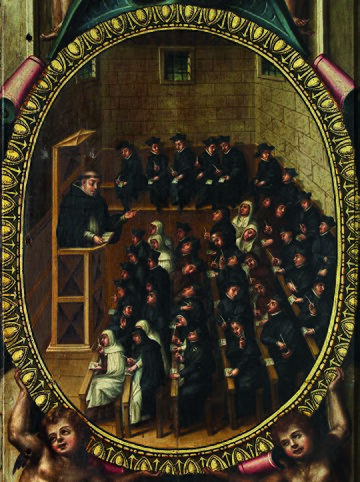
Some historians think that universities were slow to accept new scientific ideas during the Scientific Revolution. Many scientists started doing research outside of universities, often with money from rich people. However, other historians point out that most scientists of that time were trained at universities. Universities provided a stable place for learning and resources. When universities did accept new ideas, it helped make them seem more real and important.
By the end of this period, universities looked much more like they do today. The old ideas of Aristotle were less important. New scientific ways of thinking were taking over. Theology (the study of religion) was no longer the most important subject. The humanities became a key part of learning.
Modern Universities
Modern universities still have some features of old guilds. This is because early capitalism wasn't interested in controlling scholars.
By the 1700s, universities started publishing their own research papers. In the 1800s, two main university models appeared:
- German (Humboldtian) model: This focused on academic freedom, seminars (small group discussions), and laboratories for research.
- French model: This was about strict rules and control over everything at the university.
Religion became less important in university studies during the 1800s. The German model spread worldwide. Universities started focusing more on science and became open to more people. In the United States, Johns Hopkins University was one of the first to use the German research model. In Britain, new universities focused on science and engineering. Higher education became available to many more people, not just in Europe.
In 1963, a report in the UK said that universities should:
- Teach useful skills.
- Help students think broadly, not just be specialists.
- Combine research with teaching.
- Pass on culture and good citizenship.
Today, some people worry that universities are becoming too much like businesses. They say that money reasons sometimes become more important than teaching or learning.
National Universities

A national university is usually created or run by a country's government. But it often acts as an independent body within the state. Some national universities are closely linked to a country's culture, religion, or political goals. For example, the National University of Ireland was partly formed to support Irish culture and language.
Intergovernmental Universities
Some universities are created by agreements between different countries. An example is the Academy of European Law, which trains lawyers and judges in European law. The United Nations University works to solve global problems that concern the United Nations and its member countries.
How Universities are Organized

Even though each university is different, most have:
- A board of trustees (a group of people who oversee the university).
- A president, chancellor, or rector (the main leader).
- Vice presidents or vice-chancellors (who help the main leader).
- Deans (leaders of different parts of the university, like the science department).
Universities are usually split into different departments or schools, like a science department or a law school. Public universities (funded by the government) are often overseen by government education boards. These boards check money requests and approve new programs. However, many public universities still have a lot of freedom in their finances, research, and teaching. Private universities get their money from private sources and are usually more independent from government rules.
Universities Around the World
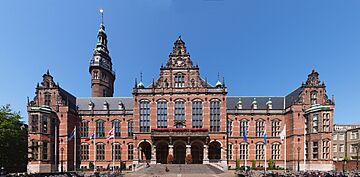
How universities are funded and organized can be very different from one country to another. In some places, the government pays for most of it. In others, money comes from donations or from students paying fees. Some universities mostly serve local students, while others attract students from all over the world and offer places for them to live.
How Universities are Classified
What counts as a "university" can vary a lot, even within the same country. Often, a government agency sets the rules. For example:
- Australia: The Tertiary Education Quality and Standards Agency (TEQSA) checks and regulates higher education.
- United States: There's no single national rule. Some states only call a school a "university" if it offers at least two doctoral degrees.
- United Kingdom: The Privy Council must approve if an institution wants to use the word "university" in its name.
- India: They have "deemed universities." These are high-quality institutions that aren't full universities but get similar rights.
- Canada: "College" usually means a two-year school that doesn't give degrees. "University" means a four-year school that does.
- Germany: The word "Universität" (university) is protected by law. These schools can give bachelor's, master's, and PhD degrees. Germany also has "universities of applied sciences" (Fachhochschule) which focus on practical skills and usually don't give PhDs.
Common Terms for University
Sometimes, people use different words for "university" in everyday talk:
- In the United States and Ireland, people often say "college" instead of "university."
- In Ireland, Australia, New Zealand, Canada, the UK, and some other countries, "university" is often shortened to "uni."
- In Ghana, New Zealand, Bangladesh, and South Africa, it's sometimes called "varsity."
Cost of University
In many countries, students have to pay tuition fees to attend university. Many students try to get "student grants" or scholarships to help cover these costs. For example, in the United States, the average student loan debt can be quite high. In some U.S. states, costs are going up because public universities are getting less money from the government.
However, in many European countries, it's possible to study without paying tuition fees at public universities. For example, in Nordic countries (like Denmark, Sweden, Finland) and Germany, public universities usually don't charge tuition fees for their own citizens or for citizens from other EU countries. They might charge a small administrative fee or fees for foreign students from outside the EU. Private universities almost always charge tuition fees.
See also
 In Spanish: Universidad para niños
In Spanish: Universidad para niños



